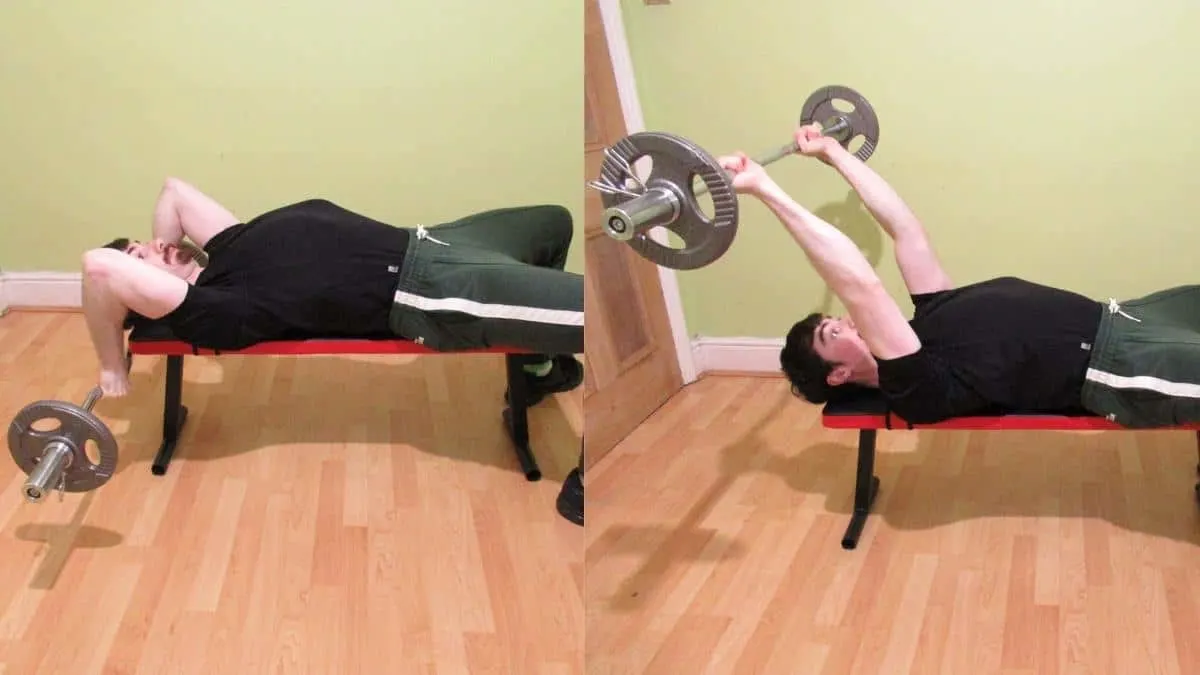The EZ bar lying tricep extension is widely considered to be one of the most effective mass-building tricep exercises due to its emphasis on the long head.
The long head is the muscle on the inner part of your upper arm that makes up roughly two-thirds of your triceps size.
So if you want to make your arms bigger, then you need to focus on building your triceps in general (as they account for two-thirds of your arm size themselves) and the long head in particular, since it’s by far the largest of the three tricep heads.
This tutorial explains how to do lying triceps extensions with the proper form and shows you the common tricep extension technique mistakes that you need to avoid. After that, we’ll discuss the benefits of EZ bar tricep extensions as well as the other exercise variations that you can do for your triceps. Finally, we’ll finish with an FAQ and some workout recommendations.
Related: EZ bar overhead tricep extension
EZ bar lying tricep extension exercise details
- Also Known As: Supine tricep extension, lying overhead tricep extension
- Main Muscles: Triceps
- Exercise Type: Strength
- Exercise Mechanics: Isolation
- Difficulty Level: Intermediate
- Equipment Needed: EZ bar, weights, bench
How to do lying tricep extensions with the proper form
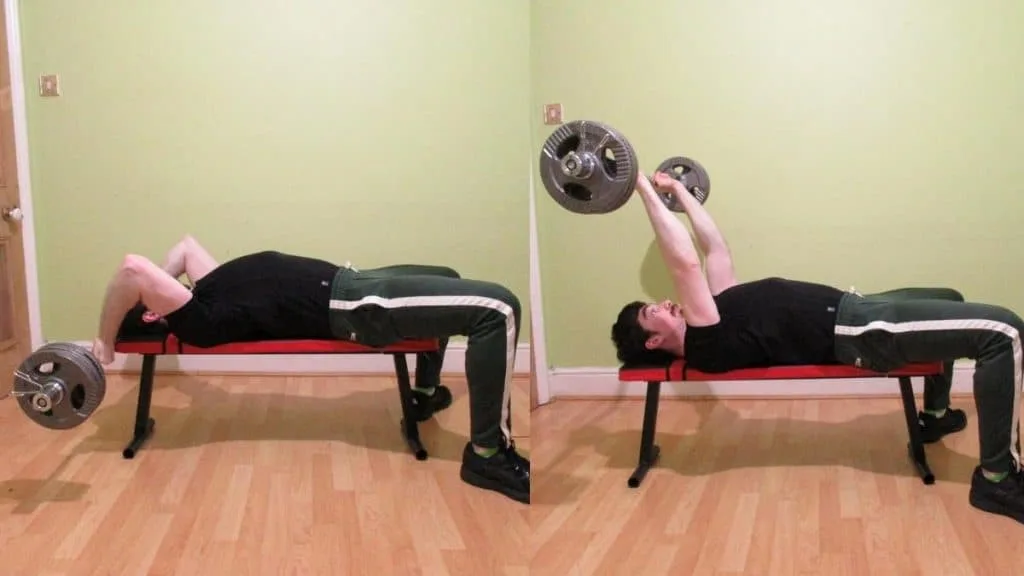
- Grab an EZ bar with a pronated grip just inside shoulder width.
- Lie back on a flat bench, and then press the weight up so that it’s directly over your head.
- Lower the bar behind your head until you feel an intense stretch in your triceps.
- Reverse the motion by flexing your triceps until your elbows reach full extension.
- Repeat for 3-5 sets of 8-20 reps.
Lying triceps extension mistakes
Some lifters complain that EZ bar triceps extensions hurt their elbows and shoulders, among other things. And while certain people definitely have worse connective tissue health than others, lying down tricep extensions are nevertheless a safe exercise if you use the proper form.
Avoiding these common EZ bar extension mistakes will give your triceps a better workout while taking tension off your joints in the process.
Lowering the bar too quickly
The lying down tricep extension is not a race; it’s a muscle-building exercise.
You get precisely zero extra points for performing your reps as quickly as possible.
In fact, failing to control the descent by lowering the bar (or should I say by dropping the bar) too quickly robs your triceps of tension and skyrockets the amount of torque going through your elbows. It’s one of the main reasons why lifters get elbow pain from tricep extensions.
Yet, dropping the bar rather than lowering it is what usually happens when you lift too much weight because your triceps don’t have the strength to lower excessively heavy weights in a controlled manner.
Your best bet for boosting your triceps activation and sparing your elbows from a brutal beating is to reduce the resistance and control every inch of the descent, otherwise known as the eccentric portion of the rep.
This way, your triceps will have to do the heavy lifting and will naturally receive more growth-stimulating tension even though you’re lifting less resistance.
Lowering the bar to your face
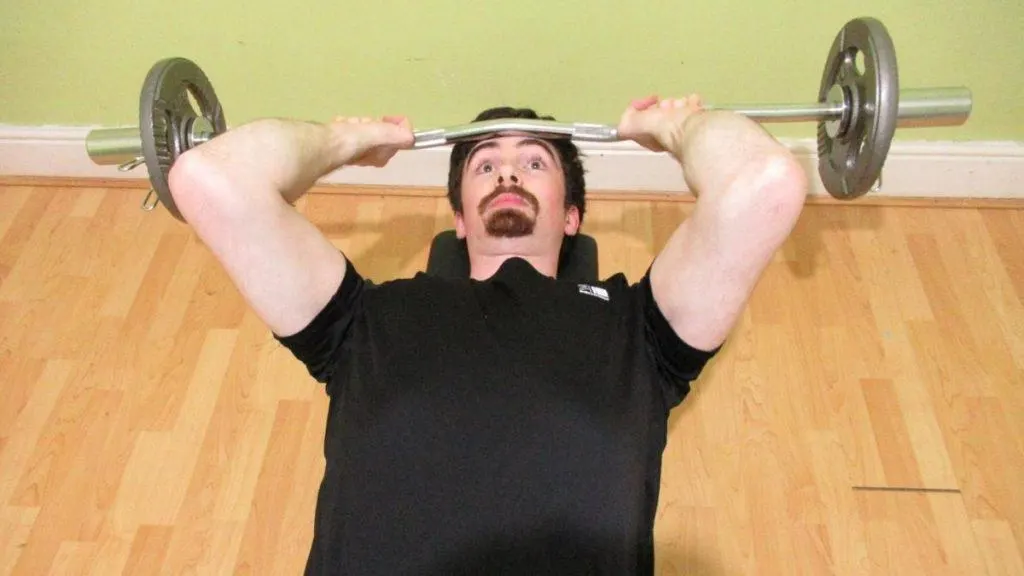
Some lifters believe that lowering the bar to your face during the flat bench tricep extension is somehow stricter than lowering it behind your head.
What they don’t realize is that they’re missing out on muscle growth by lowering the bar to their forehead, nose, or chin because they’re not putting the long head of their triceps under a sufficient stretch.
Unlike the lateral and medial heads, the long head performs shoulder extension as well as elbow extension. So in order to give the all-important long head (it’s the biggest tricep head, remember?) the best workout possible, you need to combine its functions in the same exercise.
In practice, this means allowing some backward shoulder movement as you lower the bar behind your head so that you can put your triceps under a greater stretch.
The bonus is that lowering the bar behind your head rather than to your face puts less torque through your elbows because now the tension is getting distributed across two joints (elbows and shoulders) rather than just one.
You might have to lighten the weight if you’re not used to bringing the bar deep behind your head because this technique puts the triceps in a highly lengthened position.
When a muscle is stretched out or highly lengthened, it’s naturally weaker and therefore can’t handle as much resistance as when it’s in the mid-part of its range of motion (which, for the triceps, would be a bench press or pushdown).
Lifting too heavy

Ego lifting is always something that you want to avoid because lifting excessively heavy weights can lead to injuries.
Plus, using other body parts to cheat the weights up takes tension off the target muscles.
But lifting too heavy during the lying overhead tricep extension is especially bad because the elbows are a notoriously vulnerable joint for many lifters.
Likewise, if your shoulder hurts when doing tricep extensions, then it may also be because you’re sacrificing the quality of your form in order to lift heavier weights.
As such, you should only perform the lying tri extension for moderate to high reps—even if your form is perfect.
The issue with mixing low reps and lying cambered bar extensions is that most people’s joints and connective tissue structures simply cannot keep up with the strength of their triceps. The triceps are a very powerful, fast-twitch muscle group that recovers much quicker than elbow tendons and ligaments.
So while heavy lifting can work in theory, my experience as a strength coach tells me that the majority of lifters should stick to sets of 8-20 reps in order to keep their elbows out of harm’s way.
Flaring your elbows out too much
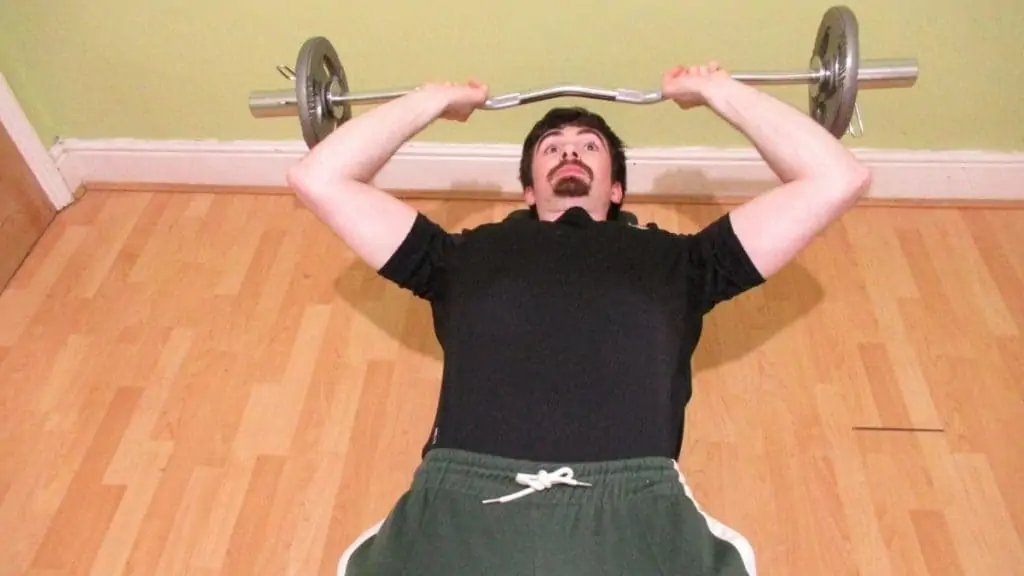
While a natural amount of elbow flare is okay and even to be expected for many people, your elbows should still point forward rather than out to the sides.
Elbow extension, the primary function of the triceps, isn’t affected by the direction in which your elbows are pointing. So, from a hypertrophy perspective, there’s no advantage whatsoever to flaring your elbows out.
There’s also a high chance that you might not even be aware that you’re flaring your elbows out.
As such, it can be helpful to ask a friend to film a set of your EZ curl tricep extensions so that you can take a look at your technique.
This can be positively eye-opening.
The supine triceps extension used to hurt my elbows, which I found strange considering that my form was textbook (or so I thought).
It turned out that I was flaring my elbows too much. And when I fixed my form, the pain went away, and I had an easier time activating my triceps during the exercise as a result.
Using the incorrect grip width
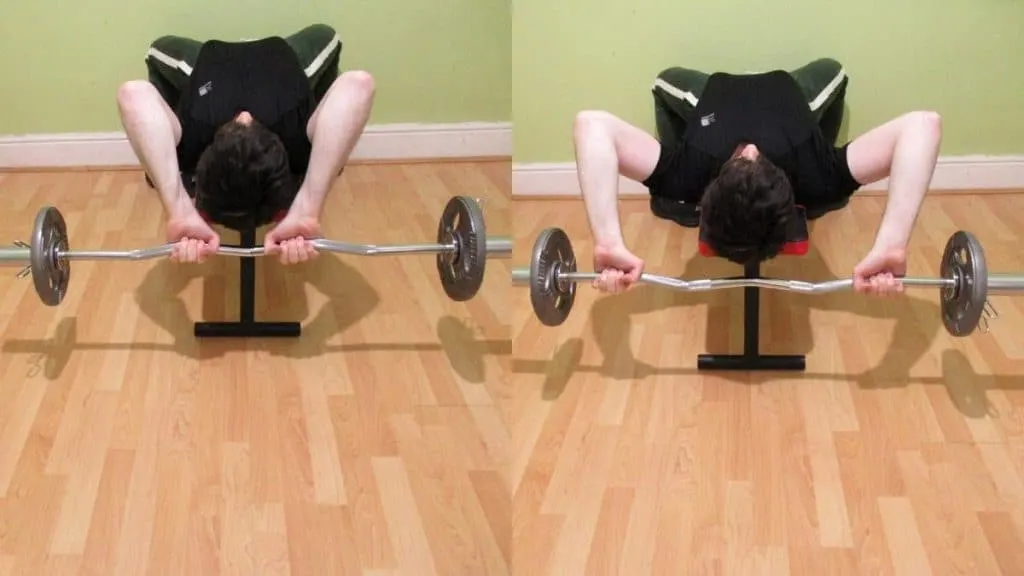
Holding the bar with an excessively close or wide grip is bad for a few reasons.
First off, using a grip that’s too narrow can put pressure on your wrists and cause your elbows to flare out. Such a grip may also cause the bar to become lopsided, which in turn leads to tricep size asymmetries if your stronger side dominates the movement.
So, by all means, do a close grip tricep extension. But don’t perform the exercise with your hands touching.
Performing a lying E-Z bar tricep extension with an excessively wide grip, on the other hand, commonly places extra strain on your rotator cuffs while also causing your elbows to flare out.
So if you want to stay injury-free and keep the tension on your triceps, then make sure to use a shoulder-width grip or a slightly closer hand position.
There is, of course, a large amount of individual variation when it comes to grip widths. The most important consideration is your comfort; you want to be able to focus on training your triceps, and that’s very hard to do when your wrists, shoulders, or elbows are uncomfortable.
So while the majority of people will prefer a close or shoulder-width grip, there’s also no issue with using a slightly wider grip for the EZ bar triceps extension if that’s more comfortable for you. Just make sure that your elbows don’t flare out excessively.
Performing half reps
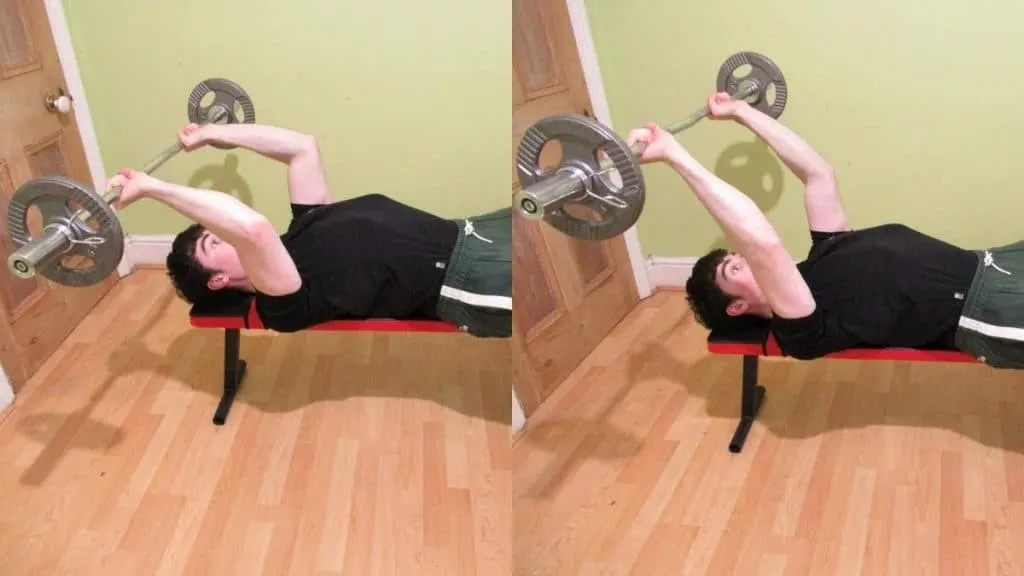
The tricep lying extension is an excellent exercise by design because when you use the proper form, it’s practically impossible to perform partial reps.
After all, if you’re truly bringing the bar behind your head rather than lowering it to your face, then you’re going to be getting a full range of motion whether you intend to or not.
Still, you can extend the lifting motion even further by lowering the bar backward and then under head/bench level to really intensify your triceps stretch.
You know that you’ve gone far enough when you feel the unmistakably intense stretch in the inner part of your triceps, which is to say in the long head.
Lying tricep extension benefits
Like any exercise, lying EZ extensions can take some time to master. But once you learn the proper form, you can look forward to larger triceps and a stronger bench press, among other benefits.
Big triceps
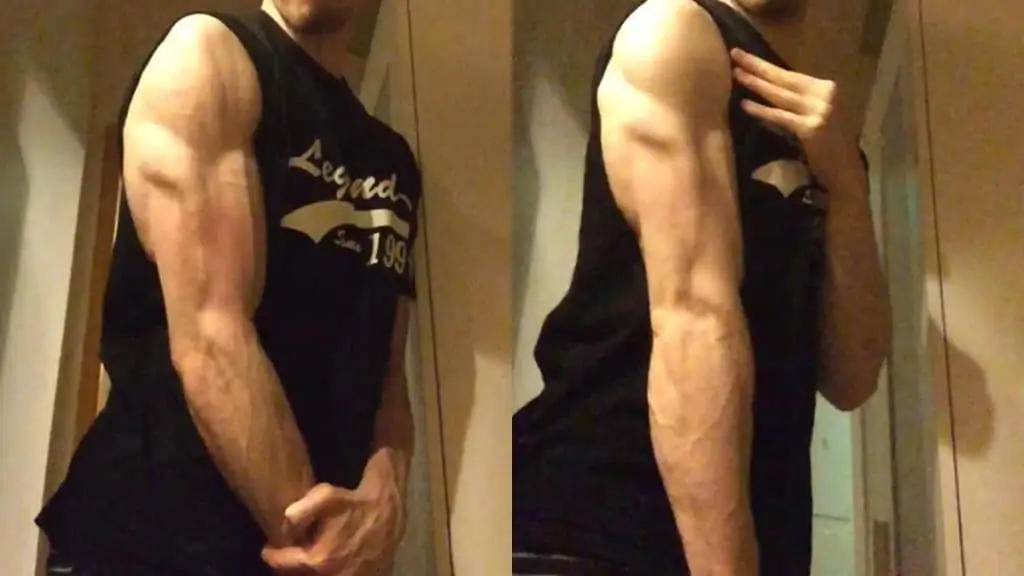
The lying EZ bar extension is an excellent tricep pushdown replacement. But it isn’t just your ordinary tricep exercise.
Unlike pushdowns et al., the flat tricep extension emphasizes the most crucial head of the triceps for building size—the long head, the one which makes up around two-thirds of your triceps size.
Located on the inner part of your upper arm, the long head of the triceps is a powerful elbow extensor that, unlike the medial and lateral heads, also performs shoulder extension.
That’s why the lying EZ bar triceps extension is such an effective mass-builder—you’re getting elbow extension and shoulder extension in the same exercise.
So if you’re in pursuit of maximum arm hypertrophy, then make sure to perform tricep lying triceps extensions early on in your workout when you have the most energy to dedicate to the exercise.
More upper arm size
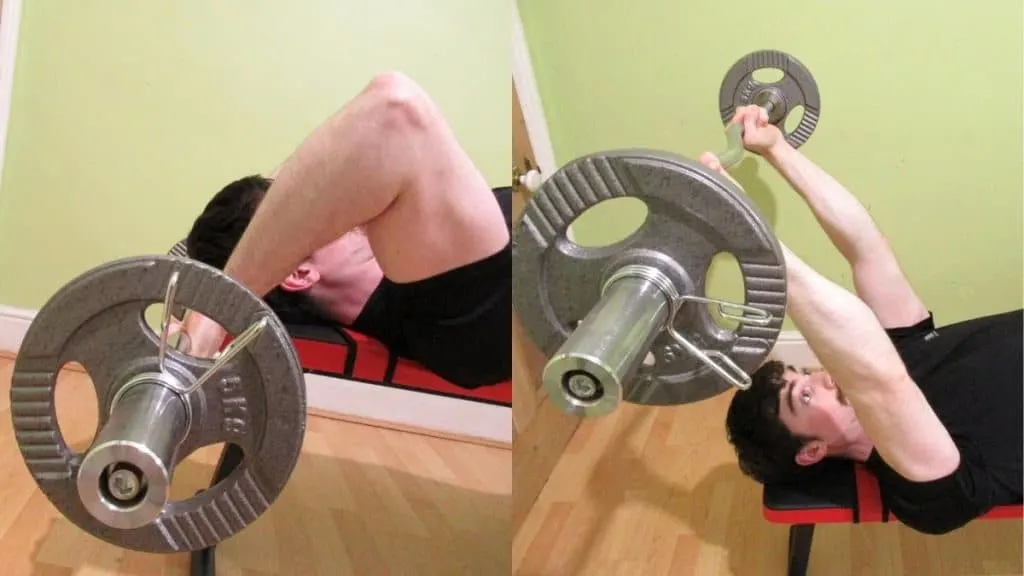
The biceps seem to get all the glory. But it’s actually the triceps that are the bigger, more important muscle for building mass because they account for two-thirds of your upper arm size.
Sure, the triceps might not be as visible as the biceps because they’re located on the back of your arm (I think that explains the bicep dominance).
Yet, if you truly want to bulk up your arms, then you have to make your triceps the priority muscle group.
As we discussed above, lying tricep extensions are one of the best exercises for beefing up your arms because they focus on the biggest region of the triceps.
So make sure to do the lying down tricep extension before your other tricep drills to take full advantage of its mass-building potential.
Stronger compound presses

There’s more to building a big bench press than having a muscular chest; you need strong triceps as well if you want to develop a powerful press lockout and set new PRs.
Whether you’re a powerlifter seeking to dominate their next meet or a bodybuilder looking to overload their pecs with more resistance, sculpting stronger triceps with lying extensions can help.
After all, you’re only as strong as your weakest link.
Powerful triceps will help you to bust through plateaus by lift heavier weights during the bench press, overhead press, and close grip bench press.
This extra weight, in turn, will help you to overload your other muscles, namely your chest and shoulders, with more resistance to make them grow larger.
So, as you can see, there’s a big knock-on effect from getting strong at the laying tricep extension.
Lying triceps extension variations
There are more than 10 variations of lying triceps extensions that you can perform. Each version has its pros and cons, which you can learn more about by checking out the tutorials below.
- Kettlebell lying tricep extension
- One arm lying tricep extension
- Lying resistance band tricep extension
- Rolling tricep extension
- Tricep plate extension
Lying dumbbell tricep extension
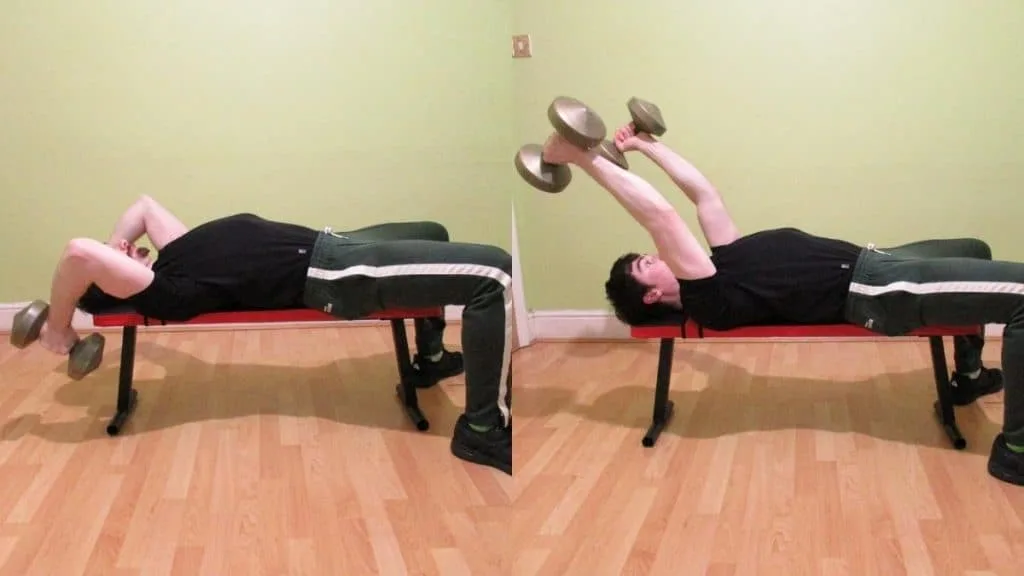
The lying dumbbell tricep extension is a helpful exercise for building a proportional pair of arms because you have to lift each weight independently.
As such, your stronger arm can’t dominate the movement, so you’re more likely to develop symmetrical triceps by choosing the dumbbell version as your primary movement.
The drawback is that you can’t lift as much weight on the dumbbell variation as you can on the lying EZ bar tricep extension because dumbbells are more challenging to stabilize than barbells.
You also can’t gain strength as quickly when you opt for dumbbells because, past a certain point, the weight jumps are often at least 5 lbs per side.
With EZ bar triceps extensions, on the other hand, you can use convenient fractional plates to smash through plateaus and gain strength on a consistent basis.
So you need to decide which physique goal is more important to you: building maximum triceps mass or optimizing your muscle symmetry?
Cable lying tricep extension
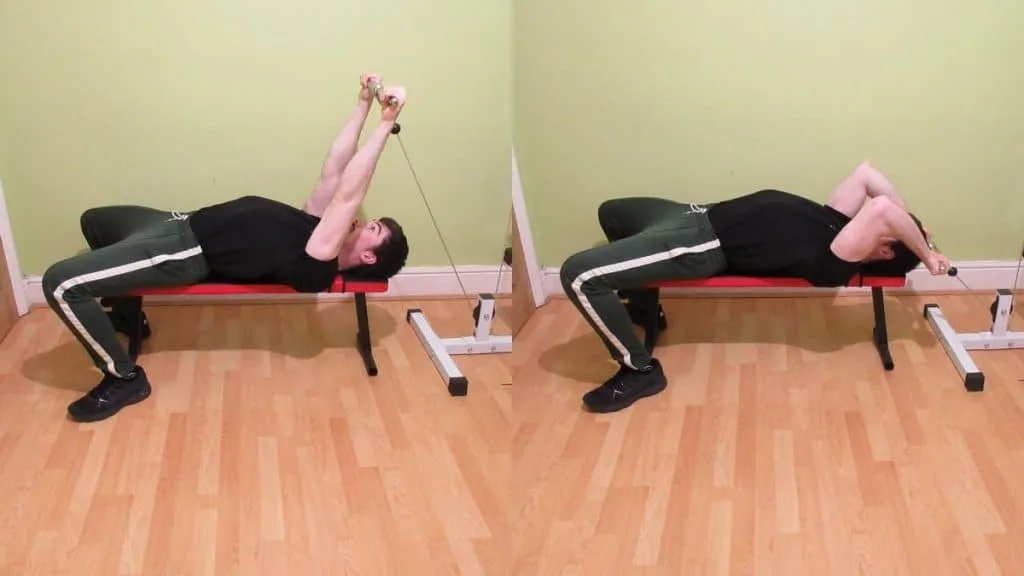
The cable lying tricep extension challenges your muscles with constant tension and a variety of different attachments.
Using a bar attachment, for example, will enable you to lift more weight than a rope will.
But using a rope provides a stronger peak contraction because you can squeeze each of your triceps individually.
Cables are also great for gaining strength because, unlike a dumbbell rack, the weight stacks on cable machines tend to ascend in very manageable increments.
This is ideal for a relatively small muscle group like the triceps because you won’t have to drastically reduce your reps in order to progress to the next weight.
Barbell lying tricep extension
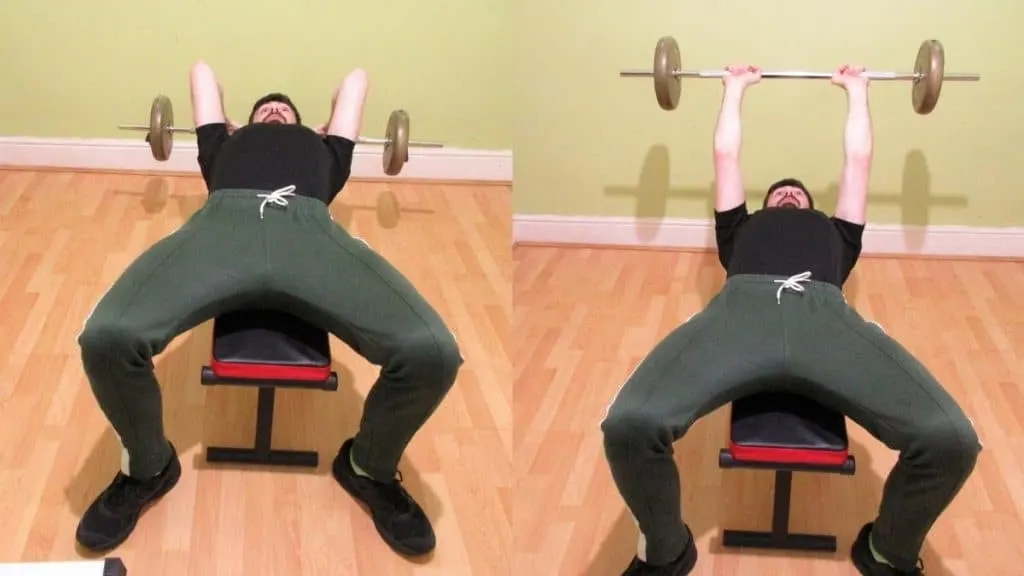
The barbell lying tricep extension is virtually identical to the EZ flat bench triceps extension, apart from the fact that you’re using a straight bar rather than an easy curl bar.
Straight bars force your hands into full pronation, which can put quite a lot of pressure on your wrists when you’re lifting heavy.
Performing an EZ tricep extension, on the other hand, enables you to take advantage of the easy curl bar’s semi-pronated grips, which naturally place your wrists in a more comfortable position.
The only advantage of using a straight bar is that it may be easier to track how much you’re lifting because Olympic bars always weigh 45 lbs.
EZ bars typically weigh about half of what Olympic bars do, but without knowing their exact weight, it can be harder to accurately track your strength progress. That is, of course, unless you’re using a preloaded bar of a fixed weight.
Lying EZ bar triceps extension sets and reps
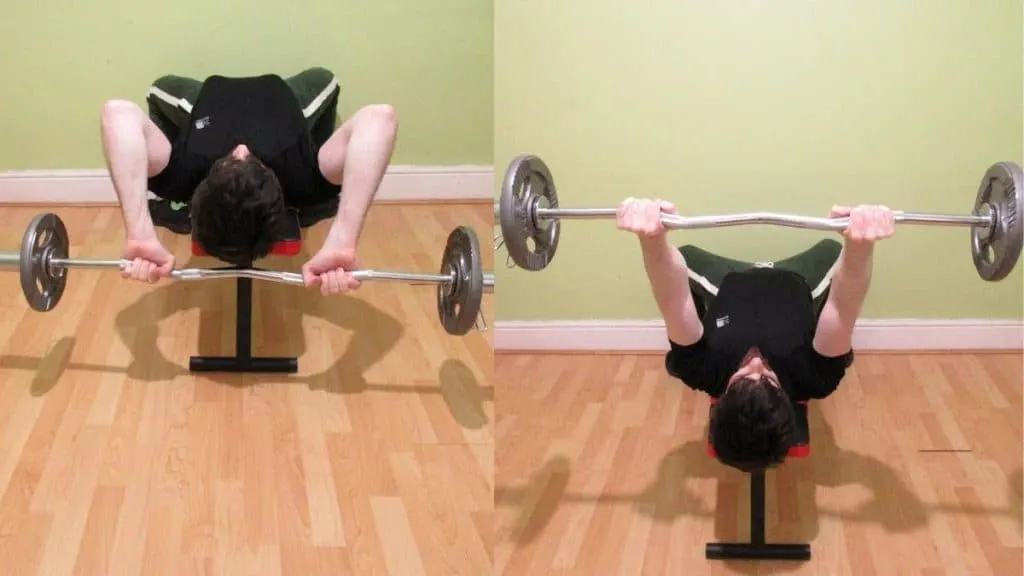
Perform 3-5 sets of 8-20 reps of the tricep EZ bar extension 1-2 times per week.
So, anywhere between 3-10 weekly sets (less if you’re a novice, more if you’re advanced) is the sweet spot for the supine tricep extension, also called the lying tricep curl.
Even though the exercise is safe when performed correctly, there’s still a certain amount of torque going through your elbows during every rep.
Therefore, it’s recommended not to exceed a twice-weekly training frequency for the lying EZ bar triceps extension because joints, tendons, and ligaments all take longer to recover than muscle tissue.
Lying tricep extension FAQ
Learn more about lying EZ bar tricep extensions—muscles worked, bench angles, safety tips—with our in-depth FAQ.
What is a lying tricep extension?
A lying triceps extension, also called a supine triceps extension, is an upper arm exercise that targets the triceps brachii muscle through a combination of elbow extension and shoulder flexion.
Because of the shoulder movement, lying triceps extensions give extra emphasis to the long head of the triceps. Considering that this is the largest of the three tricep heads, the lying extension is a popular exercise among weight trainees seeking to increase the size of their arms.
A lying tricep extension can also be performed with other strength training equipment such as dumbbells, cables, bands, and kettlebells. An EZ bar is typically the preferred training tool because the bar has semi-pronated (rather than fully pronated) grips that allow people to hold the bar more comfortably.
What muscles does a lying triceps extension work?
A lying triceps extension works all three heads of the triceps brachii muscle—the long head, the medial head, and the lateral head.
Performing a tricep extension lying down gives extra emphasis to the long head because, by bringing the bar behind your head, you’re involving your shoulders in the movement and thus putting the long head under a greater stretch (because only the long head crosses the shoulder joint).
Is the lying EZ bar tricep extension safe?
Yes, performing a triceps lying extension is safe, providing that you use the proper form and don’t do excessive amounts of training volume.
Make sure to lower the bar—under complete control—behind your head rather than to your face.
Not only does this lifting technique more or less prevent you from dropping a heavy weight on your head, but it also intensifies the triceps stretch because you’re getting a more extensive range of motion by bringing the bar behind the bench.
Just make sure that you only lift as much weight as your triceps can handle. While the triceps is a fast-twitch muscle group that responds particularly well to low reps, you should reserve low rep training for your heavy presses.
Stick to moderate or high reps for lying triceps extensions so that you don’t put too much torque through your elbows.
Why use an EZ bar for lying extensions?
Unlike a straight bar, an EZ bar has semi-pronated grips that make the bar comfortable to hold.
This enables you to focus on training your triceps to the best of your ability rather than on discomfort in your wrists.
If you’re a beginner, then you’ll likely be able to perform lying down tricep extensions with a barbell pain-free.
But as you become stronger, you’ll be putting more pressure on your wrists by forcing your hands into full pronation.
So your best bet is to stick to the EZ bar tricep extension in order to keep your wrists in a more natural position.
Is the flat bench triceps extension better than other variations?
The flat bench tricep extension is the most accessible lying triceps extension variation because it’s quicker to set up, and it doesn’t require an adjustable bench.
In fact, you could even do a floor tricep extension if you don’t have access to a flat bench.
The decline EZ bar triceps extension is a good exercise if you have a dedicated decline bench with foot holders (which are definitely necessary when you’re lifting decent weight).
Similarly, the incline EZ bar tricep extension is an effective exercise because you can get a really deep triceps stretch. The problem is that it’s risky to train to failure because you could get stuck with the barbell behind your head.
So for maximum ease of setup and safety, the flat bench triceps extension is likely the best version of lying triceps extensions.
Read More: Lying tricep extension alternative
Conclusion: Who should do lying triceps extensions?
If you want to grow and strengthen your triceps, then the lying triceps extension is an excellent exercise for the job.
The lying tricep extension is highly conducive to rapid strength gains because you can easily microload the bar with fractional plates.
Lying EZ bar tricep extensions are also safe when you do them correctly because you’re bringing the bar behind your head rather than lowering it to your face (see our skull crushers vs tricep extensions comparison for more information).
Additionally, the lying EZ bar tricep extension can boost your compound pressing power by helping you to develop stronger triceps.
So whether you want your triceps to be big and muscular, lean and toned, or strong and powerful, the lying tricep extension is a universally effective exercise that’s produced results for decades of weight lifters.

